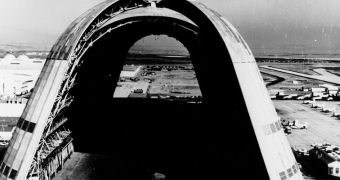Larry Page, Sergey Brin and Eric Schmidt have offered to save the giant airship hangar located at Moffett Field, California. The installation, currently managed by the NASA Ames Research Center (ARC), is now in danger of being scrapped due to lack of funding.
The facility is called Hangar One, and was one of the US Navy's largest and most impressive naval airship station. When completed in 1933, the hangar was to be used as a base of operations for the giant airship USS Macon, which flew between April 21, 1933 and February 26, 1935.
The Navy is currently stripping the outer walls of the hangar, due to the fact that they contain a host of dangerous chemicals, such as for example asbestos, lead paint and PCB (polychlorinated biphenyls). The latter were banned by the US Congress back in 1979.
Originally, NASA was supposed to use its own funds to complete a new outer layer for the iconic Silicon Valley landmark, but the economic crisis forced Congress to remove the $32 million needed for this job from the 2012 NASA budget.
Now, the top three Google executives are offering to advance the full sum needed for the repairs, on the condition that NASA allows them to use as much as 67 percent of the floor space for storing their private fleet of eight aircraft.
At this point, NASA has yet to issue an official response to this offer, even though officials at ARC received the proposal with open arms this September. However, no top representatives from NASA Headquarters, in Washington DC, advanced any comment on the issue.
The proposal was doubled last Thursday by Ken Ambrose, the director of operations at H211. The company, which is entirely owned by the three, is in charge of managing their personal airplanes. The official spoke in front of the Hangar One Subcommittee of the Moffett Field Restoration Advisory Board.
“A decision should have been made by now. It's quarter to midnight as far as I can see,” he told attendants at the conference. The Navy is scheduled to finish exposing the hangar's structure by next summer, said the chairman of the Hangar One Subcommittee, Lenny Siegel.
One of the reasons why the Google offer comes at such a good time is that the Navy has already installed a series of scaffolding to remove the outer layers of the hangar. If the covering process begins as soon as the current work is done, then the $12 million scaffolding can be left in place.
The proposal “has not yet been completely vetted. We understand the interest and historic nature of the facility and we have to weigh that against the reality of constrained resources and use,” NASA spokesman Bob Jacobs explained recently.
“We are giving all options thoughtful consideration as we prepare our funding proposal for the Fiscal Year 2013 budget,” he concluded, quoted by Mercury News.

 14 DAY TRIAL //
14 DAY TRIAL //